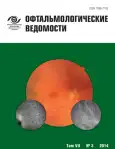Comparative analysis of vitreofoveolar traction syndrome surgical treatment
- 作者: Shkvorchenko D.O.1, Zakharov V.D.1, Rusanovskaya A.V.1, Belousova Y.V.1, Kakunina S.A.1, Mironova T.S.1, Pismenskaya V.A.1, Norman K.S.1
-
隶属关系:
- Svyatoslav Fyodorov State Institution Eye Microsurgery Complex
- 期: 卷 7, 编号 3 (2014)
- 页面: 28-33
- 栏目: Articles
- URL: https://journals.rcsi.science/ov/article/view/347
- DOI: https://doi.org/10.17816/OV2014328-33
- ID: 347
如何引用文章
全文:
详细
作者简介
Dmitriy Shkvorchenko
Svyatoslav Fyodorov State Institution Eye Microsurgery Complex
Email: shkvor@mail.ru
candidate of medical sciences, deputy Chief of the medical unit
Valeriy Zakharov
Svyatoslav Fyodorov State Institution Eye Microsurgery Complex
Email: nauka@mntk.ru
candidate of medical sciences, deputy Chief of the medical unit
Anna Rusanovskaya
Svyatoslav Fyodorov State Institution Eye Microsurgery Complex
Email: anna.rusanovskay@gmail.com
postgraduate student
Yelena Belousova
Svyatoslav Fyodorov State Institution Eye Microsurgery Complex
Email: elena.belousova26.08@mail.ru
postgraduate student
Svetlana Kakunina
Svyatoslav Fyodorov State Institution Eye Microsurgery Complex
Email: svetlan-al@mail.ru
candidate of medical sciences, researcher
Tamara Mironova
Svyatoslav Fyodorov State Institution Eye Microsurgery Complex
Email: mironova_tamara@inbox.ru
ophthalmologist
Viktoriya Pismenskaya
Svyatoslav Fyodorov State Institution Eye Microsurgery Complex
Email: v.pismenskaya@gmail.com
junior researcher
Kirill Norman
Svyatoslav Fyodorov State Institution Eye Microsurgery Complex
Email: norman2011@yandex.ru
junior researcher
参考
- Байбородов Я. В. 27G-хирургия первой стадии макулярных разрывов без витрэктомии. В кн.: Сборник тезисов «Федоровские чтения - 2011» IX Всероссийская научно-практическая конференция с международным участием; 2011.
- Стебнев В. С., Малов В. М. Симптоматическая витреомакулярная адгезия: варианты естественного безоперационного течения. В кн.: Современные технологии лечения витреоретинальной патологии. М.; 2013: 178-180.
- Bottos J., Elizalde J. Vitreomacular traction syndrome. J. Ophthalmic Vis Res. 2012; 7 (2): 148-161.
- Donald M. Gass. Reappraisal of Biomicroscopic Classification of Stages of Development of a Macular Hole./ American Journal of Ophthhalmology. 1995; 119: 752-759.
- Duker J. S., Kaiser P. K., Binder S., Gaudric A., Reichel E. The international vitreomacular traction study group classification of vitreomacular adhesion, traction, and macular hole. Ophthalmology. 2013; 120 (12): 2611-9.
- Johnson M. W. Perifoveal vitreous detachment and its macular complications. Trans. Am. Ophthalmol Soc. 2005; 103: 537-567.
- Niranjan K., Jamal K., Khalid S. Partial-thickness macular hole in traction syndrome: a case report the literature. Journal of Medical Case Reports. 2010; 4: 7-12.
- Taiichi Hikichi, Akitoshi Yoshida, Jun Akiba, Clement L. Trempe. Natural outcomes of stage 1, 2, 3, and 4 idiopathic macular holes.British Journal of Ophthalmology. 1995; 79: 517-520.
- Steel D., Lotery A. Idiopathic vitreomacular traction and macular hole: a comprehensive review of pathophysiology, diagnosis, and treatment. Eye. 2013; 27: 1-21.
补充文件







